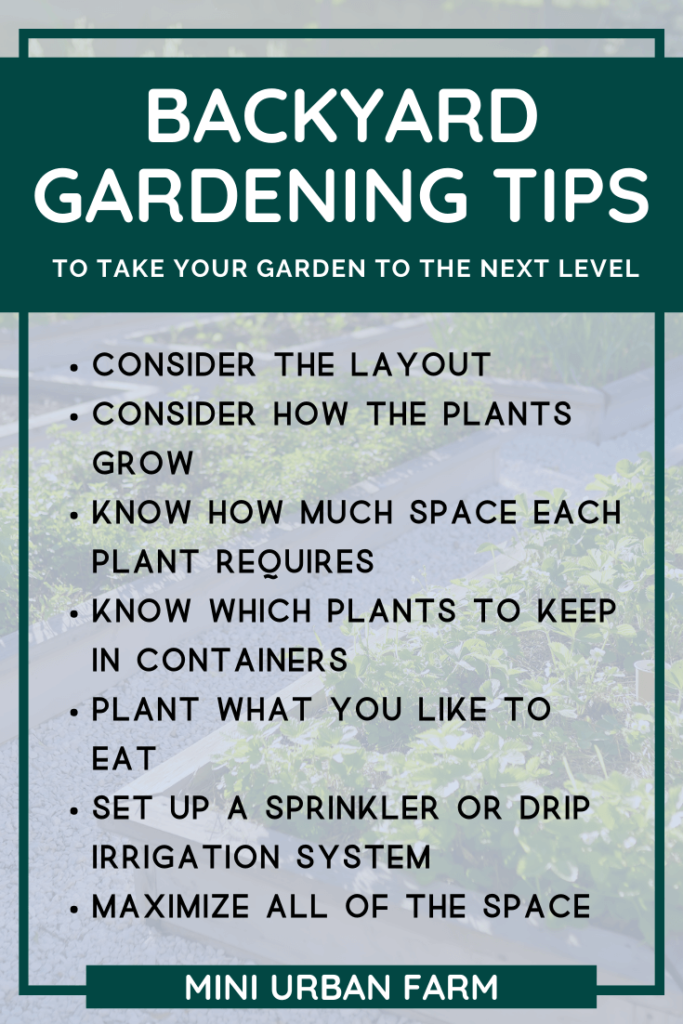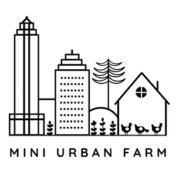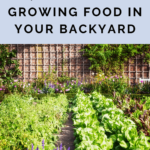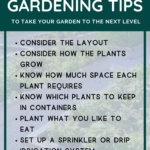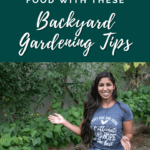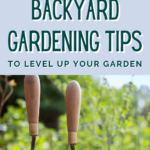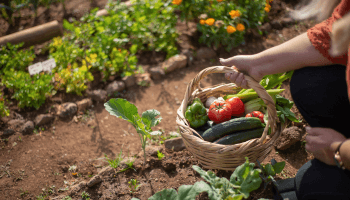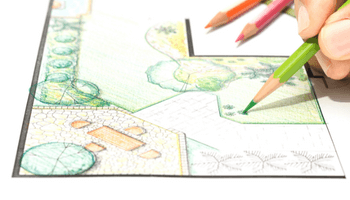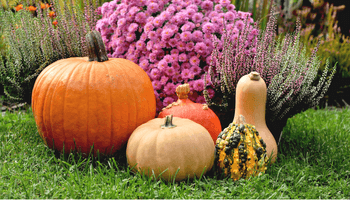If you garden in your backyard, there are a few things you’re going to want to know to maximize your space and get the most out of your garden. I love teaching people how to garden in small spaces and today, I want to share with you some of my greatest backyard gardening tips to level up your garden! These will help you grow more food and get better harvests in no time!
Backyard Gardening Tips to LEVEL UP Your Garden:
- Consider the Layout
- Consider how the plants grow
- Know how much space each plant requires
- Know which plants to keep in containers
- Plant what you like to eat
- Set up a sprinkler or drip irrigation system
- Maximize all of the space
- Benefits of Backyard Gardening

Disclosure: This post may contain affiliate links. If you purchase a product through one of our affiliate links we make a small commission from the sale at no extra cost to our readers.
Backyard Gardening Tips
Backyard gardening is a great way to make the most of a suburban home and you can get great harvests with just a few simple backyard gardening tips!
This post will cover essentials that you need to know when backyard gardening such as considering the layout, how the plants grow, and knowing how much space each plant requires.
Plus super important things like knowing which plants to keep in containers, planting what you like to eat, setting up a sprinkler or drip irrigation system, and maximizing all of the space you have!
1. Consider the Layout
One of the most important things to consider when starting your backyard garden is putting your garden in a spot that works for you.
There’s no sense in putting your garden in a place you’ll never access it!
The placement of my raised beds was definitely not an accident. My garden is pushed all the way up against the fence because we have a dog and kids, and we need a place to actually play.
We also took into account the lighting and the water, and where we were going to put the trellis – which is super important since I love growing vegetables that can grow vertically!
So before putting a garden in your backyard, whether it is a big or a small garden, consider what space you’ll want to save for your family versus what space you can dedicate to growing food.
Here are some things to consider when deciding on where and how to place your garden:
- Natural light – plants need sunlight so don’t put your garden in a spot that is absolutely shaded out and gets no light
- Rain – don’t place your garden in a spot that doesn’t get any rainwater when it rains, or that gets completely dumped on (like under a gutter)
- Trellis space – make sure to account for where to put trellises for your vining plants
- Family space – Consider the space your family and pets need to avoid collision with the garden or your plants
If you want to start a backyard garden, considering the layout is the biggest way to set yourself up for success. So take some time to make sure the layout works for you before you build your garden and it will save you tons of headaches down the road!
2. Consider How The Plants Grow
I have a whole bunch of bush beans growing in my raised beds and behind them, my cherry tomatoes that are currently growing up a trellis I’ve built against the fence!
I’ve done the same thing with my cucumbers, which are thriving on the trellis. And I’ve also planted bush tomatoes, scallions, and kale right in front of that row of cucumbers.
In the cooler months, I plant a lot of root crops, which means that they grow downward. These are crops such as carrots, radishes, beets, etc.
But the main point is that you need to know how each plant grows in order to determine where you want to put it in the garden.
For example, growing my cherry tomatoes on the trellis was not an accident. They needed it and I purposefully planted them on the back side where the trellis space is!
I have a huge trellis that goes 30 feet from one side of the garden bed to the complete opposite side of the garden – and anything that grows vertically needs to be planted along that back fence.
So the only way you’ll be able to plant successfully is if you know how each plant grows!
On the flip side, if I would have planted my vining cucumbers away from my trellis, they would have been sprawling all over the soil. Which means less space for all my other plants!
Oh and just remember that one type of veggie can have varieties that grow different ways – like bush cucumbers and vining cucumbers. So always make sure to look up the actual variety you have!
3. Know How Much Space Each Plant Requires
Not only do you want to know how plants grow, but you also want to know how much space they are going to take up!
For example, you can plant bush beans at six or nine bean plants per square foot, which gives you a lot in a little space. But you could never plant that many brussel sprouts in one square foot because they need tons of space and none of them would grow!
Trust me, I had to find that one out the hard way!
Plants such as brussel sprouts and these bigger brassicas take up a lot of space so you don’t want to crowd them.
This is where knowing how much space each plant needs comes in!
That is going to help you get the biggest and healthiest harvest. And avoid tons of headaches down the road!
And I know it can seem counterintuitive to plant less in one space – but trust me. If you give each plant what it needs, it will reward you with a bigger harvest!
Psst…want to fast track your garden? Get access to my FREE gardening resource library and start maximizing your garden today!
4. Know Which Plants To Keep In Containers
Just like you want to know how much space each plant needs, the same thing applies to which plants you want to keep in containers.
A prime example of this is mint.
I have planted my spearmint in a 12 inch container – not in my raised bed garden because mint will take over and I’ll have nothing but mint!
The same applied for thyme, oregano, and a few other plants.
For my garden, I don’t want 27 pounds of mint every season – so I’m going to just leave my mint in the container and harvest from it whenever I want.
So unless you want nothing but that one plant, make sure you separate plants with this spreading tendency.
You’ll want to plant them in a container if you want to have them— for lack of a better word — contained.
5. Plant What You Like To Eat
I know this probably sounds a little bit like common sense but believe me, it is definitely not!
When you go to the gardening center and see all these pretty things and bright shiny new plants, you’re going to want everything in sight.
So take it from me, plant what you like to eat!
I can harvest a thousand rows of radishes, but at the end of the day, if they go in the compost pile because the kids and my husband do not like eating radishes, then it is a waste.
I like radishes but I can only plant a certain amount before I can’t eat them anymore.
So if you like eating something, make sure you’re planting an appropriate amount if no one else likes eating it.
If it’s something that you’re trying out for the first time, maybe try one or two plants first, before committing – not a thousand.
This way it doesn’t go to waste when you decide you don’t actually like the taste.
And like I said, it’s not as common sense as you might think – I know multiple gardeners that have wasted space in their garden on something they found out later on they couldn’t stand – myself included!
So my best advice is to grow what you like to eat and you’ll get the most out of your garden.
6. Set Up A Sprinkler Or Drip Irrigation System
In my previous garden, I had a drip irrigation system, which went inside the beds and provided a nice drip line to all the plants.
Spoiler alert— I will be setting up something like that in my current garden very soon!
But I currently have a sprinkler system that cost me only a couple of bucks at the gardening center.
It’s attached to a hose and connected to a timer (my favorite timer to be specific!) – which which is such a lifesaver when it comes to watering the garden!
Now in summer I have it set for 7: 30 am and 8 pm every single day for 20 minutes, and it just goes off like that on repeat.
That way, I don’t have to go out and water by hand – especially when its 90 degrees plus outside!
Now, watering by hand is still an effective way of watering your plants and getting them all the nutrients that they need.
However, when I go on vacation, when I want to sleep in, when I simply forget, the manual watering kind of gets a little bit tedious.
This is where a drip irrigation line or a sprinkler comes into play.
Drip irrigation is definitely much better in my opinion because you can control the kind of emitters, sprinklers, and sprayers that you have on it.
A sprinkler system like the one I currently have just kind of sprays all the plants, and that might not always be the best for every type of plant.
However, it’s still better than forgetting to water your plants!
And since it’s saving me the time and effort that it takes to water by hand every single day, and sometimes twice a day, it is definitely worth it!
7. Maximize All Of The Space
My last backyard gardening tip to level up your garden by maximizing all of the space that you potentially have in your garden.
And as I mentioned above I have tons of veggies planted together in my raised beds.
My indeterminate (vining) tomatoes trellis along the back of my raised bed and my bush beans currently live right there in front of them.
And in between all of that I have some parsley, basil, and herbs tucked up in a companion-like fashion.
These are helping to make the plants better and get more food out of this space.
So if your goal is to grow food for your family in your backyard in the suburbs, I would encourage you to try and maximize as much space as you have!
Even if it is just a couple of raised garden beds like I currently have, or if you have a bigger area, still try to get as much food in there as possible.
I use square foot gardening in combination with companion planting and vertical gardening to get the most out of my space and make sure no available space is wasted!
Benefits of Backyard Gardening
I’ve been gardening for over 15 years and I can tell you that, without a doubt, gardening in the suburbs is awesome!
I eat fresh fruit and vegetables while also giving back to the land and it doesn’t get better than that!
But if you’re still not convinced, here are some of the amazing benefits of a suburban backyard garden.
- Improves your health – Eating fresh food keeps you away from chemicals that store bought veggies have on them
- Improves your mood – Who knew that dirt could be a natural stress reliever?
- Saves you dollars – No more spending money on sub-par produce which saves you $$$
- Keeps you fit – There really is no better way to burn those calories than by doing something you’re passionate about!
And for more gardening resources, get access to our free gardening resource library! It will help you fast track your garden and it only takes 5 seconds!
PIN Backyard Gardening Tips!

